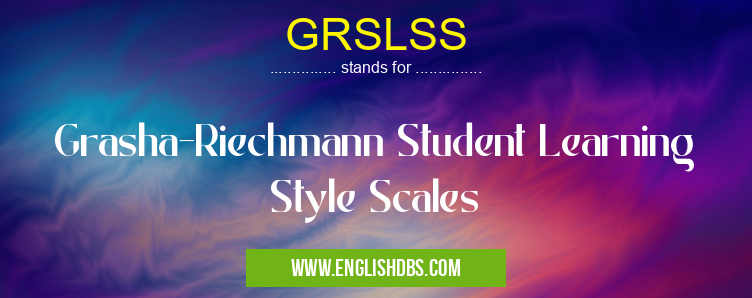What does GRSLSS mean in EDUCATIONAL
GRSLSS stands for Grashas-Riechmann Student Learning Style Scales. It is a widely used assessment tool designed to measure the learning styles of students in different educational settings.

GRSLSS meaning in Educational in Community
GRSLSS mostly used in an acronym Educational in Category Community that means Grasha-Riechmann Student Learning Style Scales
Shorthand: GRSLSS,
Full Form: Grasha-Riechmann Student Learning Style Scales
For more information of "Grasha-Riechmann Student Learning Style Scales", see the section below.
» Community » Educational
GRSLSS Assessment
The GRSLSS assessment consists of 64 items that evaluate learners' preferences across six dimensions of learning styles:
- Collaborative: Working effectively in groups
- Competitive: Striving to outperform others
- Avoidant: Avoiding academic challenges
- Dependent: Seeking guidance and support
- Participative: Actively engaging in learning activities
- Independent: Preferring to learn alone
Application in Education
GRSLSS is used by educators to:
- Identify students' preferred learning styles
- Adapt teaching methods to accommodate diverse learning needs
- Create learner-centered environments
- Enhance student engagement and motivation
- Improve academic performance
Key Features
- Validity and Reliability: The GRSLSS has been extensively validated and found to be a reliable measure of learning styles.
- Simplicity and Ease of Use: The assessment is straightforward and can be easily administered in a variety of settings.
- Flexibility: The GRSLSS can be used with students of all ages and ability levels.
Essential Questions and Answers on Grasha-Riechmann Student Learning Style Scales in "COMMUNITY»EDUCATIONAL"
What is the Grasha-Riechmann Student Learning Style Scales (GRSLSS)?
The GRSLSS is a widely used instrument for assessing individual learning styles in educational settings. Developed by Anthony Grasha and Susan Riechmann, this tool identifies six distinct learning styles based on students' preferences for learning environments and interactions.
What are the six learning styles measured by the GRSLS?
The GRSLS measures the following six learning styles:
- Collaborative: Students learn best through group work and discussions.
- Competitive: Students thrive in competitive environments where they can measure their progress against others.
- Avoidant: Students prefer to work independently and avoid social interactions.
- Dependent: Students rely heavily on instructors and classmates for guidance and support.
- Participative: Students are actively engaged in learning, asking questions, and contributing ideas.
- Independent: Students prefer to learn at their own pace and in their own way.
How is the GRSLSS used?
The GRSLSS typically involves administering a questionnaire to students, where they indicate their preferences for different learning situations and interactions. The results are analyzed to determine the primary learning styles of each student.
What are the benefits of using the GRSLSS?
Using the GRSLSS can help educators:
- Personalize instruction by catering to individual learning styles.
- Promote student engagement and motivation.
- Improve classroom dynamics and group work effectiveness.
- Identify students who may need additional support or accommodations.
Is the GRSLSS a reliable and valid assessment tool?
Extensive research has supported the reliability and validity of the GRSLSS. The instrument has been widely used in educational settings and has demonstrated its ability to accurately identify individual learning styles.
Final Words: The GRSLSS is a valuable tool for educators seeking to understand and cater to the diverse learning styles of their students. By identifying and accommodating these preferences, educators can create more effective and engaging learning environments that foster student success.
